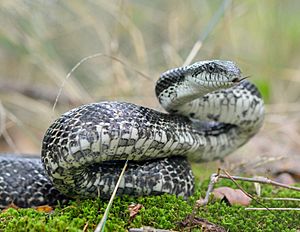Gray ratsnake facts for kids
The Gray Ratsnake (scientific name: Pantherophis spiloides) is a type of snake that lives in North America. It's also known by other names like the Central Ratsnake or Chicken Snake. This snake is not venomous, meaning it's not dangerous like a rattlesnake. It's part of a group of snakes called Pantherophis, which includes about ten different kinds of ratsnakes found in America.
Quick facts for kids Gray ratsnake |
|
|---|---|
 |
|
| Conservation status | |
| Scientific classification | |
| Genus: |
Pantherophis
|
| Species: |
spiloides
|
| Synonyms | |
|
|
Contents
About the Gray Ratsnake
The Gray Ratsnake is a medium to large snake. It usually grows to be about 3 to 6 feet long. The longest one ever recorded was over 8 feet!
What Does a Gray Ratsnake Look Like?
Unlike some other ratsnakes, the Gray Ratsnake often keeps its young patterns as it grows up. It has dark, long blotches on its back. These blotches are separated by light gray scales. Its head is light gray with dark stripes that look like a spear point. A dark band goes across its eyes and back towards its neck.
However, if you find a Gray Ratsnake in the northern parts of its home range, it might be black when it's an adult. Its belly is usually off-white or light gray with darker spots.
Where Gray Ratsnakes Live
Gray Ratsnakes are found in North America. They live mostly in the eastern and central parts of the United States. You can find them along the western side of the Appalachian Mountains. Their range stretches from southwestern New England all the way down to the Gulf of Mexico. They also live west to the Mississippi River and north from Louisiana to Wisconsin.
Gray Ratsnakes in Canada
In Canada, these snakes are found in two separate areas of southern Ontario. One area is near Lake Erie, and the other is in the Great Lakes/St. Lawrence region.
What Kind of Places Do They Like?
Gray Ratsnakes are very good climbers. They feel at home both on the ground and high up in trees. They live in many kinds of hardwood forests. They also like areas along tree-lined streams and fields. Sometimes, you can even find them around barns and sheds near people. Any place with lots of rodents to eat and places to climb is a good home for a Gray Ratsnake.
What Gray Ratsnakes Eat
The Gray Ratsnake is a skilled hunter. It uses its sense of smell to find food. It's also a powerful constrictor, meaning it squeezes its prey. Adult Gray Ratsnakes mainly eat small mammals like mice and rats. They also eat birds and bird eggs. Young Gray Ratsnakes, called neonates or juveniles, prefer to eat frogs and lizards.
How Gray Ratsnakes Behave
When a Gray Ratsnake gets scared, it usually stops moving. It will hold its body in a wavy shape. The snake might also shake its tail against whatever it's lying on. This makes a buzzing sound, like a rattlesnake, even though it's not venomous.
If it feels threatened, the Gray Ratsnake will raise its head and pretend to strike. If you try to pick it up, it might release a bad-smelling liquid from its body. This is called "musking." It might also bite if it feels it needs to. However, Gray Ratsnakes are less likely to bite than some other snakes. If they do bite, the wound usually only needs a small bandage.
Gray Ratsnake Life Cycle
Gray Ratsnakes usually breed between April and July. Female snakes become old enough to have babies when they are about 7 to 9 years old. They lay their eggs around the middle of summer. A female can lay anywhere from 5 to 27 eggs. The baby snakes, called hatchlings, are usually about 10 to 12 inches long. They typically come out of their eggs in September.
Protecting Gray Ratsnakes
The Gray Ratsnake is common in many places. However, some areas are worried about their numbers. In Michigan, they are listed as "of special concern." This means their population is being watched closely. They are also considered rare in Wisconsin.
In Canada, the Gray Ratsnake is listed as "endangered" in the Carolinean population. The Great Lakes – St. Lawrence population is listed as "threatened." This means these groups of snakes are at risk.
In the state of Georgia, it is against the law to kill or catch any native nonvenomous snakes. These snakes are protected by the Georgia Department of Natural Resources.
Two main reasons why Gray Ratsnake numbers might go down are:
- Habitat destruction: When their homes (forests, fields) are destroyed.
- Road mortality: When snakes are hit by cars on roads.




